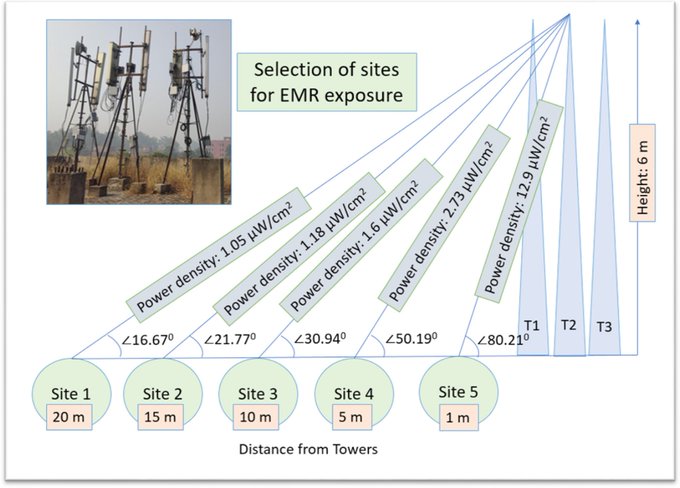This study conducted by Ankita Sharma, Surbhi Sharma, Shalini Bahel, and Jatinder Kaur Katnoria, published in the journal Environmental Monitoring and Assessment, investigates the effects of non-ionizing radiations emitted from cell phone towers on the environment, specifically using an Allium cepa (common onion) test system. The context of this research is rooted in the increasing concerns over the potential health and environmental impacts due to the proliferation of electronic devices and the infrastructure (like cell phone towers) that supports them.

Key Components of the Study:
- Objective: To evaluate the effects of non-ionizing radiations from cell phone towers on various biological parameters of Allium cepa (onion) plants.
- Methodology:
- Cell Phone Towers: Three towers, labeled T1, T2, and T3, emitting radiations at different frequency bands (800, 1800, 2300 MHz for T1; 900, 1800, 2300 MHz for T2; and 1800 MHz for T3) were selected.
- Sites: Five sites (S1 to S5) with varying power densities (from low to high) near these towers were chosen for the study, with a sixth site having zero power density serving as a control.
- Measurements: The study measured the mean power density at each site, changes in morphology, root length, weight of Allium cepa, protein content, antioxidant enzyme activity (including ascorbate peroxidase [APX], superoxide dismutase [SOD], glutathione-S-transferase [GST], guaiacol peroxidase [POD], and glutathione reductase [GR]), and genotoxicity effects.
Findings:
- Power Density: The mean power density ranged from 1.05 μW/cm² at site S1 to 12.9 μW/cm² at site S5.
- Biological Effects: Significant changes were observed in the morphology, root length, fresh and dry weight of Allium cepa exposed to radiations at different sites, indicating stress or damage due to radiation exposure.
- Protein Content: There was a significant difference in protein content in the roots across all sites and in the bulbs particularly at sites with higher radiation (S4 and S5) compared to the control.
- Antioxidant Enzyme Activity: Significant changes in the activity of antioxidant enzymes were noted, suggesting an increased oxidative stress response in the plants exposed to higher radiation levels. This was particularly evident at sites S4 and S5.
- Genotoxicity: The study showed that exposure to radiation, especially at the site with the maximum power density, led to genotoxic effects, inducing abnormalities at different stages of the cell cycle in the root tips of Allium cepa.
Implications:
This research highlights the potential adverse effects of non-ionizing radiation from cell phone towers on biological organisms, in this case, demonstrated through changes in Allium cepa. The findings suggest that radiation exposure can lead to oxidative stress and genotoxicity, which could have broader implications for environmental health and safety. It underlines the importance of monitoring and potentially regulating the emissions from cell phone towers to minimize their environmental impact.







